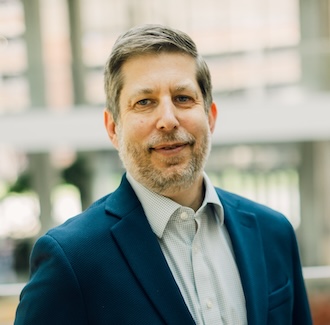Student Spotlight: Colton Castro
Feb 6, 2023/chwe-newsroom/img_3581.jpeg?sfvrsn=88574abb_0)
" I love the constant pursuit of new knowledge and that OSH
professionals continuously push the boundaries in reforming
policy to better protect workers from new insults. "
How did you find yourself in the field of OSH?
Ironically, I found myself in OSH kind of accidentally. During my undergraduate studies, I took a class with Dr. Schaeffer called “Environmental Health” that was simply to complete part of my major requirements. However, during that class, I began to evaluate the chemical and physical insults affecting workers. I was entranced by the thoroughness of the course, as well as the immediate application into what affects people outside of the usual bacteria and viruses. I immediately delved into environmental health classes and was continuously surprised by how much there was to learn and know.
I also like to joke that I wouldn’t be in the OSH field if Dr. Schaeffer would not have pulled me out of the classroom right after completing a final that I was taking for his class, to talk to me about OSH.
What piqued your interest in studying this field?
There is always a way to make a difference in OSH and there is so much to learn. Even experts in their fields such as Steve Reynolds, PhD, MS, and Lee Newman, MD, MA , are constantly learning new information. I love the constant pursuit of new knowledge and that OSH professionals continuously push the boundaries in reforming policy to better protect workers from new insults.
What attracted you to the MAP ERC?
In my undergraduate degree, I worked on a project that was funded under High Plains Intermountain Center for Agricultural Health and Safety (HICAHS), another NIOSH-funded center similar to the MAP ERC. In applying to my current program, I was directed to the MAP ERC which promotes collaboration amongst disciplines—something I found to be unique amongst the vast amount of research institutions in the U.S. Upon attending the MAP ERC Research Day Symposium, I met faculty and fellow colleagues in the MAP ERC, and I immediately felt at home. Everyone was supportive of what I wanted to accomplish and very friendly.
/chwe-newsroom/5e77eb52-0db8-4ed8-a13b-318fa8702629.jpg?sfvrsn=73554abb_0&MaxWidth=600&MaxHeight=&ScaleUp=false&Quality=High&Method=ResizeFitToAreaArguments&Signature=57AE66FD23E03B504199DF99499CE32FC392425A)
Tell us about an impactful project you’ve worked on as a part of the program.
I am working on a project in Guatemala that is actively researching risk factors contributing to chronic kidney disease of unknown origin (CKDu). Specifically, I am researching an alternative method to analyzing for amorphous silica as the current standard is extremely time/cost heavy and destructive in nature. Through an innovative combination of Fourier-Transformed-Infrared-Spectroscopy (FTIR) and an FTIR Microscope, we hope to develop predictive quantitation models. These models will help further quantitate and differentiate various heavy metals along with amorphous silica present in the samples that have potential nephrotoxic effects in a non-destructive manner.
What important lessons did you learn from your professors or through this project?
The most important lesson I learned was to be thankful for the opportunity to conduct research as unique as this. I have also learned the importance of being prepared for everything. Since we were often an hour or more away from the sugarcane mill, we had to ensure that we packed backups to our backups to prevent the risk of losing samples from being unprepared. I learned that whirl-pak bags are quite versatile in their use. Shoutout to the clinical team for that discovery!
What lessons did you learn by working with classmates in and outside of your program field?
I have learned that each of our backgrounds gives us a unique view on how to approach occupational health and safety much like how each part of a machine makes it whole. I would also say that my classmates outside of the program gives us an excellent multi-prong approach to Total Worker Health®, something that is essential to improving individuals’ health and help them return home better than when they left.
/chwe-newsroom/img_0980.jpeg?sfvrsn=1d574abb_0) Did you have any misconceptions about this program, field, or project that have since been resolved?
Did you have any misconceptions about this program, field, or project that have since been resolved?
Quite frankly, I thought environmental health was going to solely focus on improving the environment. I was surprised to find out everything that it encompasses. I also was not sure what I was expecting the program to be like aside from taking classes. I have been amazed at the amazing opportunities we get, such as touring a uranium mine, or visiting various industries in/around Fort Collins, CO, and even getting the opportunity to represent the MAP ERC during the yearly visits to the U.S. Capitol.
How will your training/experience impact the larger body of workers, families, and communities?
My experience interacting with the sugarcane farmers in Guatemala has improved how I communicate complex scientific topics to populations who may not share the my same level of education. Additionally, my experience impacts workers, families, and communities because in the U.S., agricultural communities are often located in counties with very little access to medical care. In Colorado alone, there are multiple eastern counties that don’t have physicians actively practicing. Through my current interactions with agricultural workers and my previous opportunities to interact with individuals working in agriculture, I will be able to understand the needs of populations at risk.
What is the next step for you after exiting the program?
I anticipate applying to medical school to earn my medical degree and begin a residency in occupational medicine. I aim to return to a rural area to practice occupational medicine while continuing to research and educate workers in occupational health.




